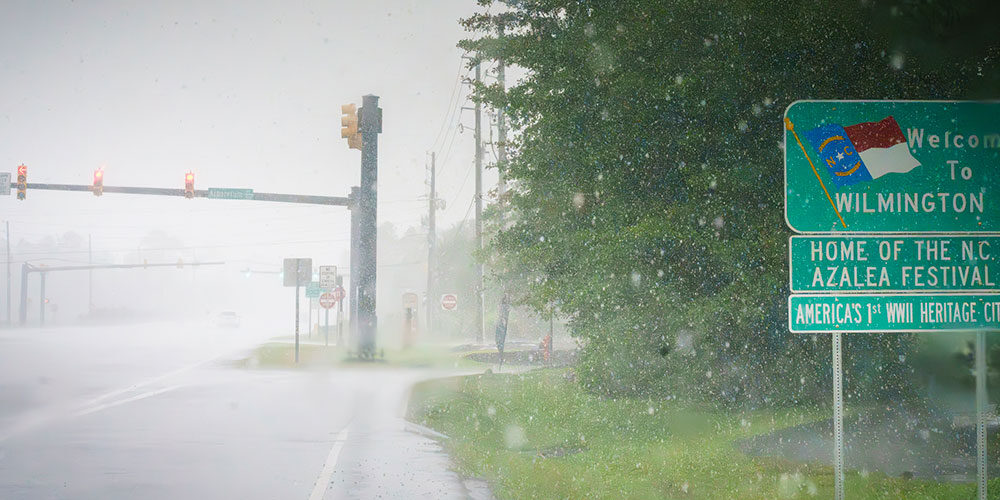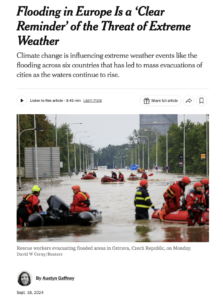Super soaker
In the fall of 2018, I traveled to Washington, D.C., and the small town of Churchton, Maryland, on the shores of Chesapeake Bay. At that time, it had been the wettest year on record.
I was there to sell a family house and as I walked through the yard, I was surprised to see standing water.
The word “sodden” kept coming to mind, and I envisioned a pile of heavy, soaked towels as I slogged through each step.
In October, I had put the house on the market in seemingly good condition. Later that month, I got a call that flooding was causing issues under the house. Water had gotten to the floor joists. The water table had gotten so high that the water was above ground. With the bay just a couple of hundred yards away, there was no downhill drainage. The house was in a swamp.
I asked around the neighborhood and learned that several people faced the same problem. A flourishing business arose as homeowners decided to raise their foundations a foot and replace the joists.
This was the first time I realized — even without deluging precipitation or a hurricane — that these communities would be rendered nonviable because of accumulating water. It is being flooded without actually having a flood.
This week, I did an interview with the New York Times on floods in Europe, followed almost immediately by another interview on enormous floods occurring worldwide.
It is a good time to frame this situation.
Not only do these events provide context for the changing climate, they give us a starting point to consider the impact on us as individuals.
The accumulating water is the result of an accumulation of heat on a global scale. Of course, this raises the air temperature, but I am going to focus on what is happening to our large bodies of water.
It’s getting hot in here
Ocean temperatures, bay temperatures, and lake temperatures are all rising. Because of this, evaporation increases and there is more water in the atmosphere. This is a direct consequence of physics.
With more water in the atmosphere, there is more water available for precipitation. As discussed in my series of articles on storytelling and scenarios, this increased potential for precipitation is one of the few aspects of a warming climate that directly follows from the temperature increase.
Though the Chesapeake Bay and the Great Lakes create important local effects, the ocean poses far more significant impacts. In the summer of 2023, ocean temperatures were rising fast enough to catch the attention of the climate-aware public. In the following year, record-high temperatures spiked month after month. Only recently have the high temperatures eased slightly off “warmest ever observed.”
Though 2023 and 2024 caught the casual observer’s attention, the recent trend is consistent with what we have seen for decades. We have fluctuations in the global temperatures associated with El Niño and La Niña. El Niño is warmer, La Niña is cooler. Since the 1982-83 El Niño event, each subsequent El Niño has seen a jump in temperature. After the jump up, we do not return to the cooler temperatures of even the previous decade.
This warming is relentless. Note: I wrote warming. We have not arrived at some appointed temperature at which the temperature will stop warming. We should expect warming to continue until we effectively intervene to reduce the emissions and amounts of carbon dioxide and methane in the atmosphere.
Cartoons of frogs arguing about the temperature as they sit in a pot of heating water are, sadly, increasingly apt.
In short, the atmosphere has more and more water in it, and when the conditions are right to cause rain, the rain is far more likely to be extreme. That means that virtually any type of storm — not just a hurricane or extreme thunderstorm — can have extreme precipitation.Just this week a small disturbance on the coast of North Carolina, to the surprise of many residents, caused upwards of two feet of rain to fall. We saw something similar in Houston earlier in the year. Extreme events occur routinely, such as this one in August 2024 in Connecticut.
Back in April, I did an interview on floods in the United Arab Emirates. The desert environment was an unusual place for this type of extreme weather event, which caused massive amounts of rain and damage.
With the global warming of the oceans, any rainmaking storm can have far more rain than in the past.
Time for an intervention
These events have redirected my thinking about rain and flooding: I am not starting with what rain used to do. I am starting with what rain is doing now, and thinking how it will continue to change.
Here are a few new ideas that crystalized for me while thinking about these floods and our future.
- First, we really are just at the beginning of this.
- Second, we are talking about these events, in the here and now, as extreme. However, we have not sampled this new warming climate. We do not know what is average and what is extreme. It is, perhaps, wiser to frame what we are experiencing now as representative, not extreme.
- Third, the observations discussed in the IPCC reports and the US National Climate Assessment are lagging indicators. The climate is changing more quickly than the time to publish peer-reviewed papers and execute massive international assessments of that information. When thinking of problem-solving we require more agility in our knowledge generation.
- Fourth, because of the ability of weather systems to transport water vapor thousands of kilometers, the rising temperatures in distant oceans can bring global warming to a place in non-intuitive ways.
Unfortunately, I expect we’ll see inevitable increases in extreme precipitation for the coming decades. Until we have huge reductions in emissions and the amounts of carbon dioxide and methane, we have no credibility in saying that warming and wetting of the atmosphere will not increase. Therefore, we are left with adaptation choices that are difficult, expensive, and local.
Now is the time to relearn how to live with our weather and climate.
(Lead image: Stock photo of heavy precipitation in Wilmington, North Carolina, in August 2024.)





Abigail Welborn - 2004 LSA
When I read Jeff Goodell’s “The Water Will Come” (https://www.amazon.com/Water-Will-Come-Remaking-Civilized/dp/031626024X) this year, I was shocked to realize it was published “way back” In 2017. Even then he was talking about Miami being underwater. Many reactions to his reporting were along the lines of one Realtor, who said, “We can’t say that! No one would buy any houses!” People just don’t want to believe it could be that bad, so they maintain willful ignorance.
Reply
Jonathan Blanton - 1975
This is an interesting and thoughtful article with useful insights and recommendations. However there is no convincing evidence that human produced emissions are the primary cause of the current climate warming, nor any evidence that “intervening” by reducing such emissions makes a significant difference. It may seem counterintuitive to “climate activists”, but the most effective action we can take to deal with the worldwide problems associated with climate warming is continuing fossil fuel production with advancing technology, hardening and modernizing our energy infrastructure, and resuming and increasing nuclear energy power production with the latest engineering technology.
Reply
Richard Rood - Did not graduate
Hi, see below. “quotes” are your original comment
“This is an interesting and thoughtful article with useful insights and recommendations.”
Thank you.
“However there is no convincing evidence that human produced emissions are the primary cause of the current climate warming, nor any evidence that “intervening” by reducing such emissions makes a significant difference.”
Your sentence requires me to respond
There is convincing evidence that human produced emissions are the primary cause of the current climate warming.
“It may seem counterintuitive to “climate activists”, but the most effective action we can take to deal with the worldwide problems associated with climate warming is continuing fossil fuel production with advancing technology ”
That reminds me of the drug addict saying the best thing to do is to continue to take the drug and rely on some treatment technique to make things ok.
Reply